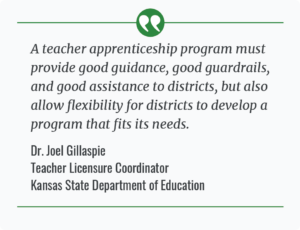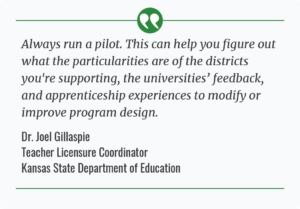Voices from the Field spotlights stakeholders in Region 12 and their work to improve educational opportunities and outcomes. R12CC is privileged to collaborate with and share the insights of Dr. Joel Gillaspie, Teacher Licensure and Registered Teacher Apprenticeship Coordinator at the Kansas State Department of Education.
 In his role with the Kansas State Department of Education (KSDE), Dr. Gillaspie is supporting the design, promotion, and implementation of Kansas’ Registered Teacher Apprenticeship program. He serves as the state’s subject matter expert to provide customer service to districts and apprentices.
In his role with the Kansas State Department of Education (KSDE), Dr. Gillaspie is supporting the design, promotion, and implementation of Kansas’ Registered Teacher Apprenticeship program. He serves as the state’s subject matter expert to provide customer service to districts and apprentices.
The Kansas State Department of Education (KSDE) recently developed a Registered Teacher Apprenticeship program. Can you please share why this program was selected and provide a brief overview of progress to date.
The main impetus behind this program was for KSDE to help design additional teacher development pathways and help districts think long-term about employment. In 2016, KSDE asked several universities, Wichita State University primarily, to develop residency programs and start thinking about residency licensure to give individuals more opportunity in the classroom before acquiring their actual teaching license.
Traditional teacher preparation requires 12 to 16 weeks of student teaching in the last semester of the program. For many teacher candidates, that is either a great or horrific experience. Some people realize they aren’t really prepared to deal with kids effectively. The first or second year on their initial licensure can be rough because there are so many real-world classroom skills to develop. Some universities in Kansas learned that residency programs are a helpful way to get more experienced individuals in the classroom.
During the summer of 2022, Shane Carter, the Director of Teacher Licensure, started a working group with stakeholders from across the state that included school districts, KSDE’s Office of Apprenticeship, the Kansas National Education Association, and university and community college points of contact. The goal was to start thinking about the apprenticeship model and how it could be implemented in Kansas. The working group continued through spring 2023 when the Kansas legislature passed the Kansas Apprenticeship Act which gave tax credits to for-profit businesses that employed apprentices in the healthcare field. That legislation also required KSDE and the Department of Commerce to establish a Registered Teacher Apprenticeship program.
At that time, KSDE had most of the program structure completed but needed to finalize and get approval from the Department of Commerce on some portions. In March, the program standards were finalized. In April, the standards were submitted to the Kansas State Board of Education for review. In May 2023, the state board approved the standards, and the licensure team immediately submitted the application with the finalized standards to the Kansas Office of Apprenticeship for approval. The summer of 2023 was spent designing a pilot program for the state. The team selected 13 pilot apprentices from six districts of varying size.
Since August 2023, a pilot has been ongoing with an improvement goal of identifying deficiency areas, clarifying district and university guidance, and developing a method to disseminate information. We started with one university as part of our pilot, but now any Kansas university with a fully online teacher preparation program is eligible to participate.
What’s it been like to try to develop some of those relationships across districts, educator preparation programs, and with the apprentices, as well as developing the guidance and building that mentorship model for the districts to use?
We’re introducing the idea of an apprentice to public education because when you talk to somebody in district personnel, it’s either: para, instructional aide, or teacher. There’s no in-between. It’s about talking to districts and sharing that an apprentice is a teacher in training but they’re not a para; they are a teacher in training. We’ve also spent time working on the guidance, the small intricacies of each district, and how to introduce the apprentice person/role to a district from a budget perspective, from an instructional perspective, and from the employment side.
What does a successful RTA program look like from your perspective?
-
At the state level?
-
In districts/schools?
-
For aspiring teachers?
A successful Registered Teacher Apprenticeship program in Kansas really hinges on districts thinking about it as a career pathway for teachers in which the state provides the structures to create the pathway as a viable option. A program must provide good guidance, good guardrails, and good assistance to districts, but also allow flexibility for districts to develop a program that fits its needs. Each district is unique in geography, culture, location, and size. We let them figure out how an apprenticeship program works in their context. We let districts be creative when it comes to their training and developing their teacher pipelines and pathways. 
A successful district is a district that is training their own team and hiring their teachers to be successful. But at the state level, it’s about KSDE being useful to districts and providing guidance.
Also at the state level, we are relationship facilitators between the districts and the universities. We’re all invested in the district building and training new teachers who also attend a university. The university and districts should work together. Our role at the state level is to help facilitate and be useful partners.
A successful Registered Teacher Apprenticeship for aspiring teachers is one in which they get to spend four years learning what it’s like to be a teacher, while simultaneously going to school. Then they’re taking all their pedagogy classes, and their education classes—it’s not just theory at that point. They learn and can apply it in the classroom they’re working in.
What tips for designing, implementing, or evaluating a Registered Teacher Apprenticeship program would you give to others who may be interested in developing their own?
Talk to other states that are implementing a Registered Teacher Apprenticeship program, because, as of right now, each state is taking a different approach. As you talk to each state, ask them to share their standards and ask questions to understand what their standards look like in practice.
Get your stakeholders together. Include districts, individuals within your own agency, the state’s Department of Education or Department of Labor, and educator preparation programs to determine if there is an appetite for an apprenticeship program and who is interested.
Determine the funding you have available. Depending on how much money you have, you must be very cognizant of which barriers you want to tackle because you can’t do all of them.
Talk to the apprentices, talk to the district administrators and anybody that will give you good feedback. Figure out how to build on that feedback and establish your direction.
Always run a pilot. This can help you figure out what the particularities are of the districts you’re supporting, the universities’ feedback, and apprenticeship experiences to modify or improve program design.
The Region 12 Comprehensive Center has partnered with KSDE to develop a logic model and evaluation plan for the Registered Teacher Apprenticeship program as well as collect data from the pilot implementation. How would you describe the support from the Region 12 Comprehensive Center?
The best way to describe the support is “phenomenal” because we had to think through and really work on developing our logic model, thinking through our data collection processes, and what we actually want to accomplish. We started designing our program prior to working with R12CC and we had pie-in-the-sky ideas. The R12CC helped us hone in on the program design and evaluation questions.
R12CC’s capacity-building support helped us figure that out and helped us ask the right questions to determine where to go with the project. The R12 Comprehensive Center gathered our first round of data from the pilot program, and it was invaluable in helping KSDE think through this program, what we want to accomplish, and what our data collection and reporting will look like in the short-term and then the long-term. If we want districts to really buy in and become part of a change in Kansas when it comes to teacher education, we must collect and report on quantifiable data and metrics.
